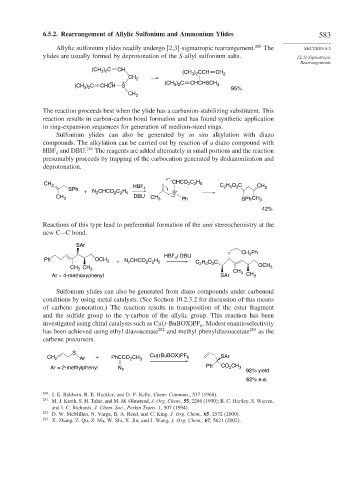Page 609 - Advanced Organic Chemistry Part B - Reactions & Synthesis
P. 609
6.5.2. Rearrangement of Allylic Sulfonium and Ammonium Ylides 583
Allylic sulfonium ylides readily undergo [2,3]-sigmatropic rearrangement. 280 The SECTION 6.5
ylides are usually formed by deprotonation of the S-allyl sulfonium salts. [2,3]-Sigmatropic
Rearrangements
(CH ) C CH (CH ) CCH CH 2
3 2
CH 2 3 2
– + (CH ) C CHCHSCH
) C CHCH S 3 2 3
(CH 3 2
95%
CH 3
The reaction proceeds best when the ylide has a carbanion-stabilizing substituent. This
reaction results in carbon-carbon bond formation and has found synthetic application
in ring-expansion sequences for generation of medium-sized rings.
Sulfonium ylides can also be generated by in situ alkylation with diazo
compounds. The alkylation can be carried out by reaction of a diazo compound with
HBF and DBU. 281 The reagents are added alternately in small portions and the reaction
4
presumably proceeds by trapping of the carbocation generated by dediazonization and
deprotonation.
–
CH 2 HBF CHCO C H C H O C
2 2 5
SPh 4 2 5 2 CH 2
+ N CHCO C H S +
2
2 2 5
CH 3 DBU CH 3 Ph SPh CH 3
42%
Reactions of this type lead to preferential formation of the anti stereochemistry at the
new C−C bond.
SAr
CH Ph
/ DBU 2
HBF 4
Ph OCH 3 + N CHCO C H C H O C
2 2 5
2
2
2 5
CH CH 3 OCH 3
3
CH 3
Ar = 4-methoxyphenyl SAr CH 3
Sulfonium ylides can also be generated from diazo compounds under carbenoid
conditions by using metal catalysts. (See Section 10.2.3.2 for discussion of this means
of carbene generation.) The reaction results in transposition of the ester fragment
and the sulfide group to the -carbon of the allylic group. This reaction has been
investigated using chiral catalysts such as Cu t-BuBOX)PF . Modest enantioselectivity
6
has been achieved using ethyl diazoacetate 282 and methyl phenyldiazoacetate 283 as the
carbene precursors.
S
CH 2 Ar + PhCCO 2 CH 3 Cu(t BuBOX)PF 6 SAr
Ar = 2-methylphenyl N 2 Ph CO CH 3 92% yield
2
62% e.e.
280 J. E. Baldwin, R. E. Hackler, and D. P. Kelly, Chem. Commun., 537 (1968).
281
M. J. Kurth, S. H. Tahir, and M. M. Olmstead, J. Org. Chem., 55, 2286 (1990); R. C. Hartley, S. Warren,
and I. C. Richards, J. Chem. Soc., Perkin Trans. 1, 507 (1994).
282 D. W. McMillen, N. Varga, B. A. Reed, and C. King, J. Org. Chem., 65, 2532 (2000).
283
X. Zhang, Z. Qu, Z. Ma, W. Shi, X. Jin, and J. Wang, J. Org. Chem., 67, 5621 (2002).

